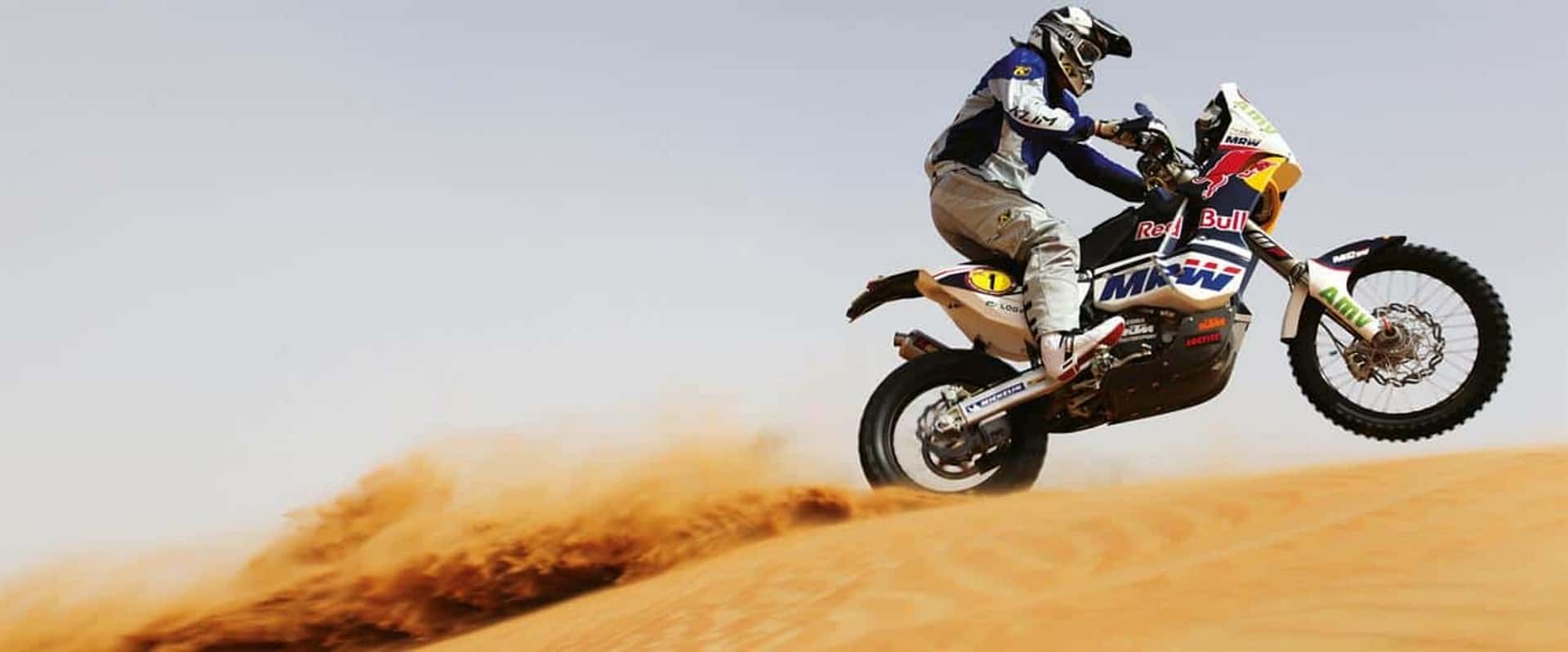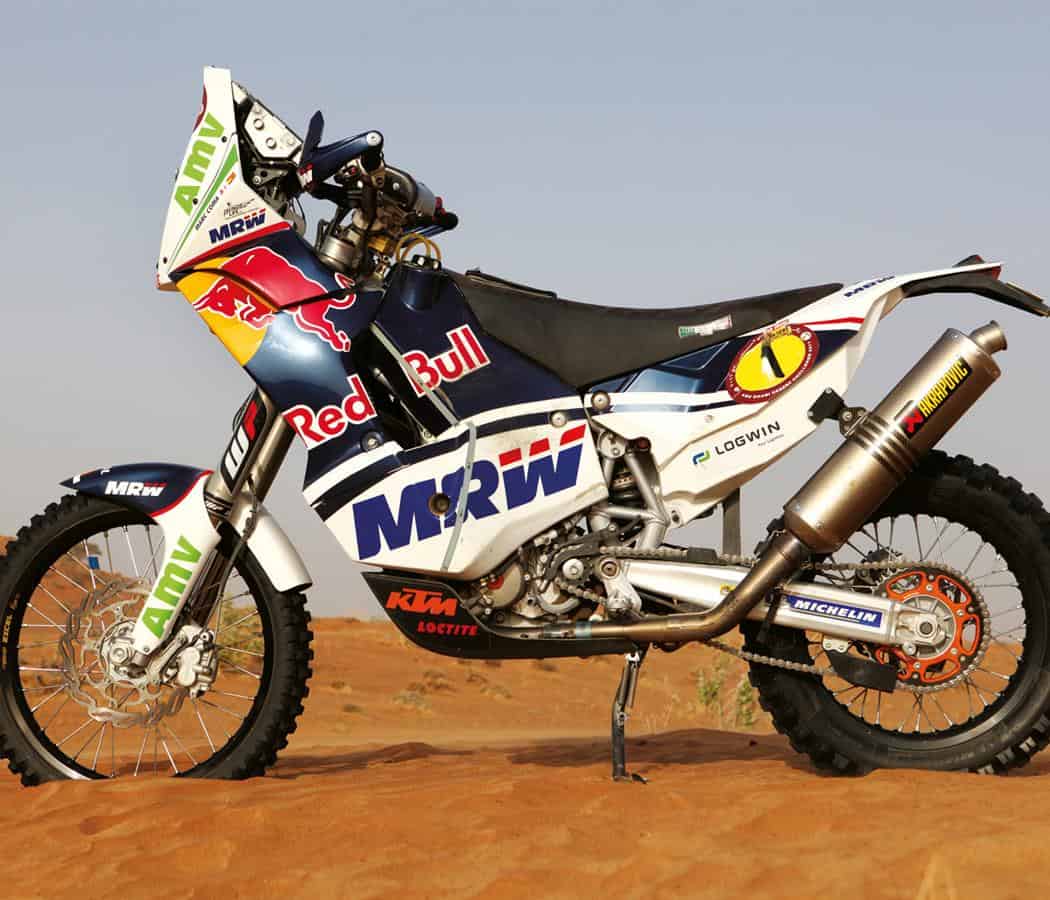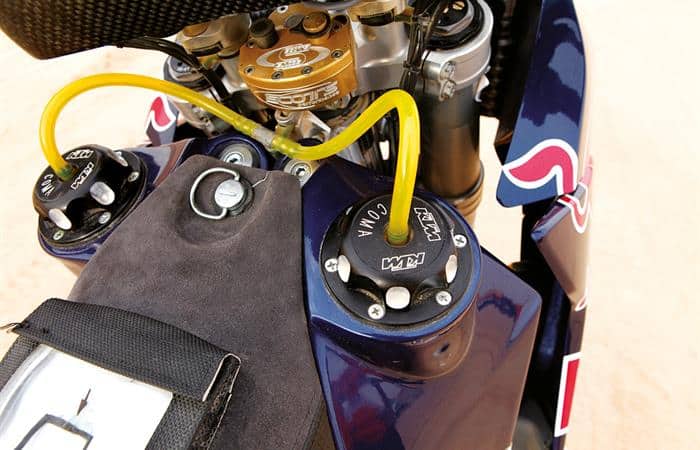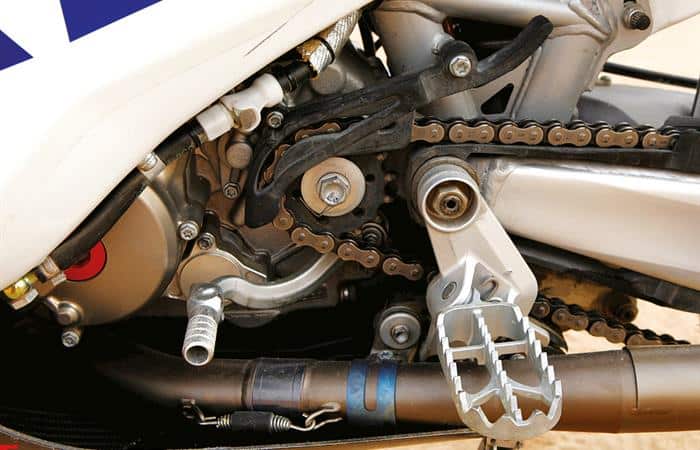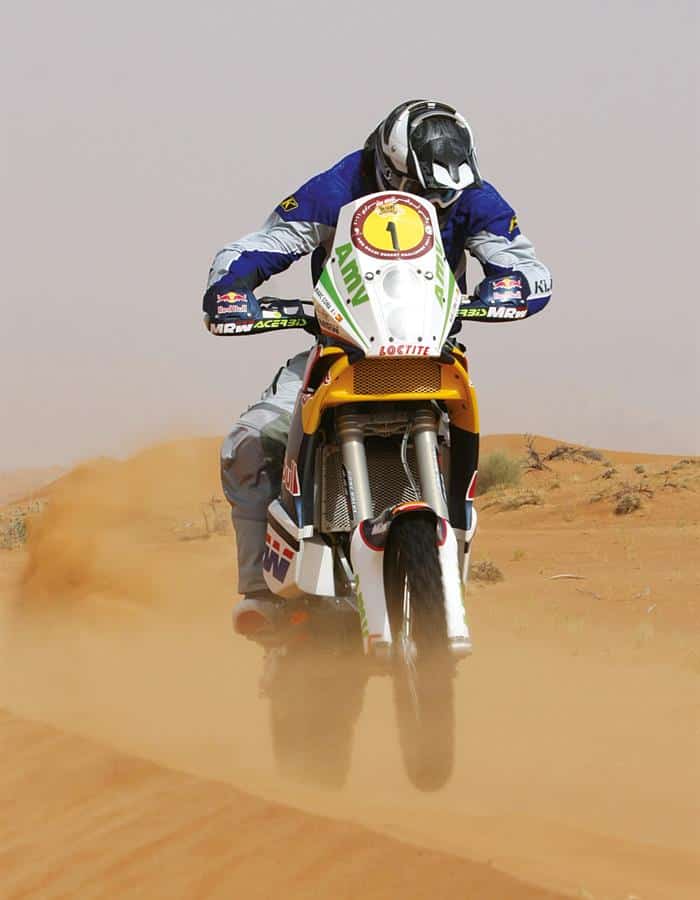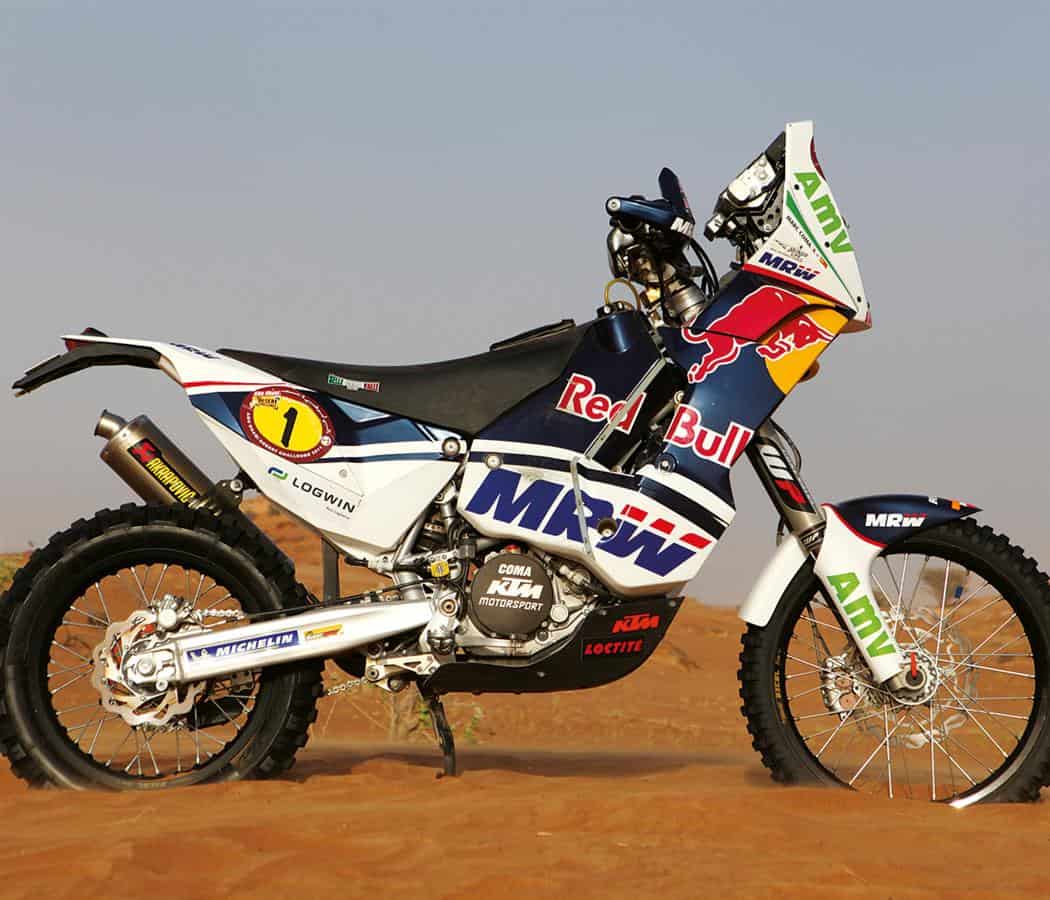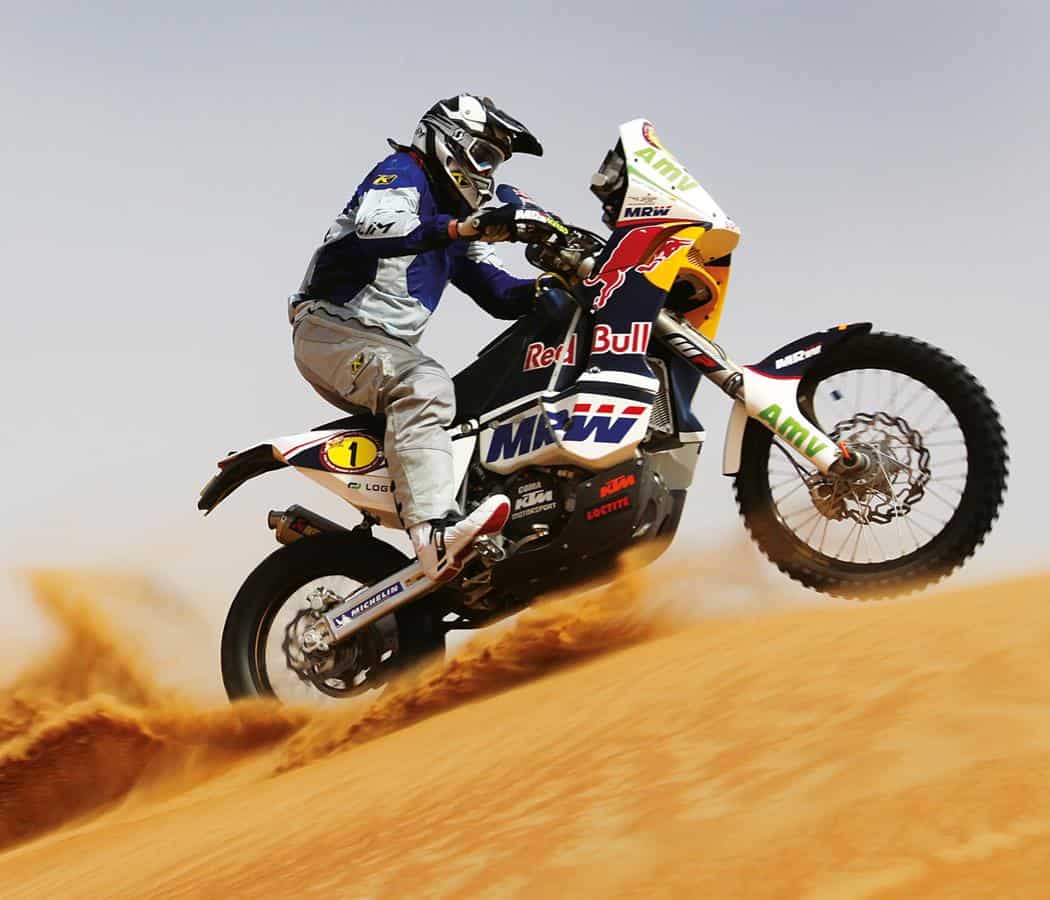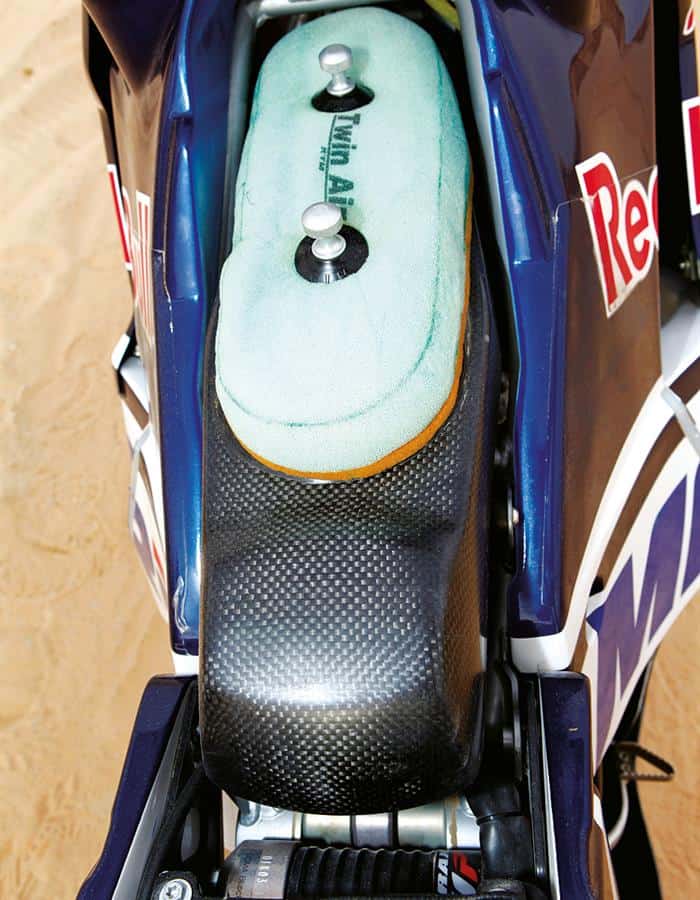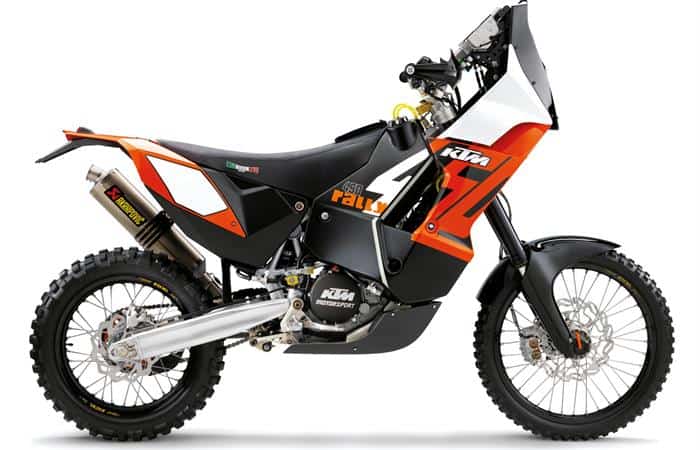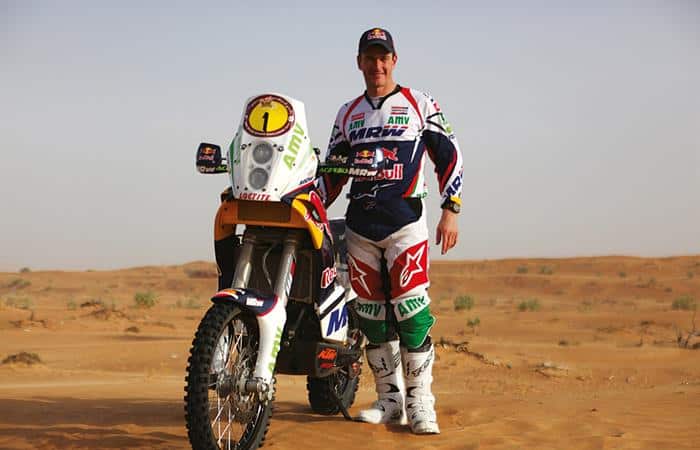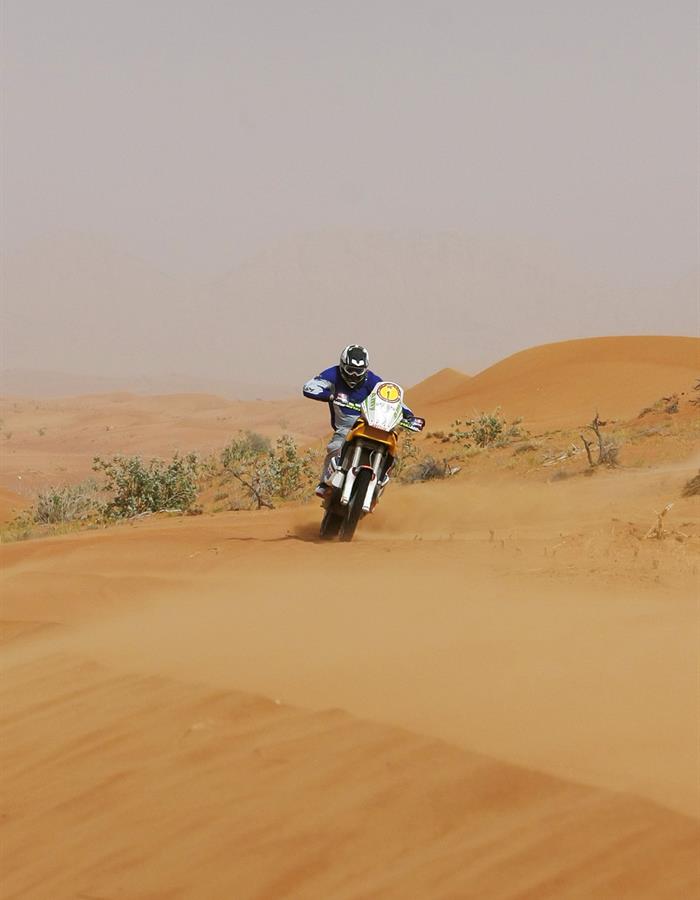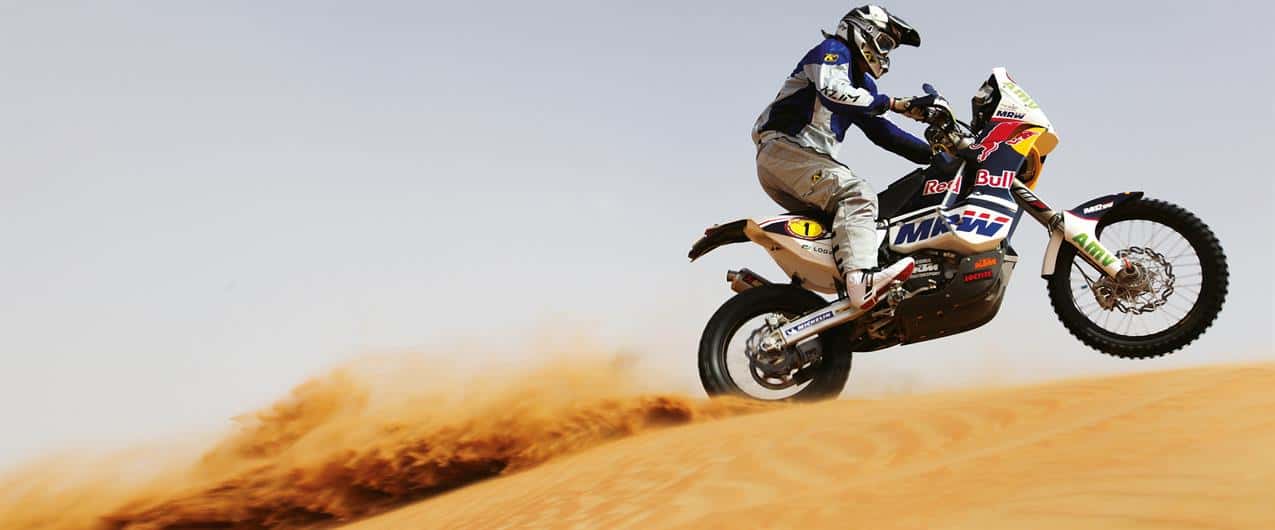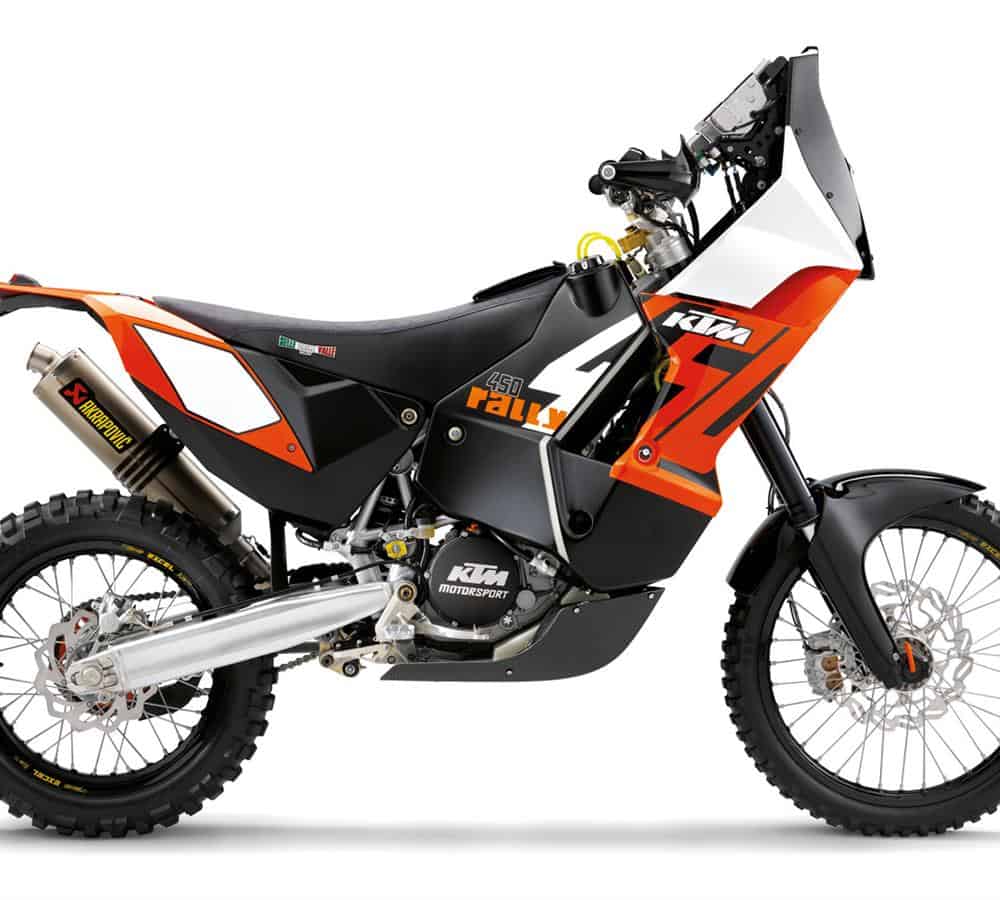With the desert rally scene now dominated by 450cc machines, In 2011 Barni flew out to Dubai to ride the most successful of the new breed, KTM’s 450 Rally…
The throttle’s to the stop as I feed in another gear. The 450 motor responds with another surge of power and howls through its titanium exhaust. We’re making pretty rapid progress but I can’t let the revs drop. The warm soft sand will sap momentum, and as we start to climb I’m forced to drop a gear and then pin it again. The bike storms up the climb though I can’t help but feel a little mechanical sympathy for it – for the past 20 minutes I’ve been what is technically known as ‘giving it death’.
Still, I’m confident that the bike can take the abuse. Because, coinciding with the release of their ‘customer’ 450 Rally (see boxout at the end), KTM have invited us out to the Middle East to test their team bikes. And the bike I’m riding on my first ever time in the desert makes the experience akin to losing your virginity to Angelina Jolie. Because, fresh from winning the Abu Dhabi Desert Challenge, the bike I’m riding is Marc Coma’s factory 450!
Against the Grains
We’ve covered the rally scene’s shift away from big-bore singles to 450 machines before, so we won’t dive deep into the subject now, except to say that the move was instigated by ASO, the Dakar organisers, two years ago and at the time KTM weren’t overly chuffed with the French organisation’s decision. After all, their big-bore singles had given them almost a decade of continuous Dakar victories. But this year the new 450 Rally took a maiden Dakar victory at the hands of Coma, with Cyril Despres chasing him home on a similar machine, consigning the big-bore bikes to the history books. It’s only in the World Cross Country Rally Championship that the open class remains…
Desert Storm
Watching the bikes as they pull into a pit garage at the ultra-modern, Formula One standard, Yas Marina race circuit after the final stage of the Desert Challenge, almost all are 450s. Only the 690 of Poland’s Marek Dabrowski has snuck inside the overall top ten. There are the 449 Husqvarna’s of the Speedbrain team, the WR-based machine of Yamaha’s Helder Rodrigues, ‘satellite team’ KTMs, and coming in after them innumerable dealer-built specials, based on enduro machines, in varying states of disrepair. Bodywork hanging off, graphics peeling, cable-ties abound. At the front of the line is Coma’s 450, looking as fresh as a daisy bar a light coating of dust. The man himself seems just as composed.
The bike looks slightly out of place in the spotless confines of the garage, though the following day it’s back out in the desert with the hazy sun illuminating the iridescent paintscheme that adorns its fibreglass flanks. It’s spotless, and with the exception of a space where the rally organisers’ GPS unit would sit, race-ready.
Unlike almost all of the other manufacturers’ 450 rally bikes, the KTM isn’t based on an enduro model or simply an existing model with bike tanks and a fairing. The factory briefly tried the compact EXC chassis but found that it wasn’t stable enough for the high speeds and heavy fuel loads that desert rallying demands, and so they used something already proven in the field: the steel trellis frame and alloy swingarm from the 690 Rally.
Another benefit of using the trellis frame is that the motor is suspended in it, rather than enclosed by it like a conventional cradle frame. This means that removing the engine takes far less time – undo a few bolts and drop it out, rather than the faff of extracting it through the frame.
You might expect to see a grunty enduro lump in a rally bike, though with big power a priority in desert rallying KTM have instead utilised their twin cam 450cc motocross engine. Naturally it’s come in for a few changes, mainly in order to ensure that it can withstand the long stages and extreme conditions associated with the sport. Crucially, the lubrication system has been modified with a larger stronger oil pump for greater circulation and a large external oil filter replaces the internal one that you’d find on the standard SX-F lump. An oil cooler is plumbed in – drawing air from under the chin of the fairing – in order to keep the lubricant temperature in check.
A 41mm Keihin carb had to be modified in order to draw from the carbon-fibre airbox mounted above the motor rather than the traditional rear-mounted intake. Although fuel injection would cope better with the extremes of altitude found in the Dakar, the ‘nuts ‘n’ bolts of a traditional carb make it far easier to fix should something go wrong. The Keihin then feeds into a CNC-machined cylinder head, which then exhales through a single Akrapovic titanium pipe.
Internally, the engine is given a stronger crank, pushing an upspecced piston via a Pankl con-rod, with Hinson clutch parts replacing the standard unit. To prevent these parts inadvertently escaping through the cases, the rev limiter has been lowered from 11,700rpm to 10,500rpm. The SX-F ignition system has also been boosted with the fitment of a 140w alternator in order to power the lights and nav gear.
Like the MXer, the gearbox holds five ratios, albeit they’ve been revised and the output shaft is now larger in order to withstand the rigours of constant high-speeds.
Factory forks grace the front-end, 52mm units with alloy internal tubes, with a similarly trick WP shock at the back-end. They’ve got their work cut out, softening the blows on a bike which weighs 145-kilos without fuel.
The tanks hold 36L in total – 18 at both ends – providing more than enough range to cover the 250km the rally rulebook demands without refuelling. This is the same tank capacity as the 690 though the self-supporting rear subframe has been slimmed-down on the 450. ‘You had to pay attention on the 690 when the rear tank was full’, explained Marc, ‘now you can play a bit more.’
Looking closer at Marc’s bike, alongside touches such as the carbon-fibre surround for the rear filler cap there are also a number of neat rally-prep details. Wrapped around the front brake line in a perfect roll is a few metres of handy duct tape; a nylon webbing ‘Beemer’ strap is tucked underneath the bar mounts; and a Leatherman multi-tool is tied to the nav gear ‘tower’ by right-hand fork leg – ‘very good for when you get fence wire in your wheel’ comments Marc. The rest of his toolkit nestles in a space under the seat.
Sand Blast
Sheltering under an awning, I await my call whilst necking bottle after bottle of icy water. Back home it’s the hottest day of the year so far, a very spring-like 20 or so degrees. Here in the desert it’s nearly double that!
Opening the cooler chest to extract another bottle, I hear my name called. It’s my turn. I’ve a choice of two bikes: Coma’s or Ruben Faria’s – the number one plate or the number nine. Which would you choose? Exactly…
I almost feel bad with my choice as Ruben is sat waiting aboard an enduro bike to guide me around our makeshift, constantly shifting, lap. The bike is pushed forward off its roadrace-style paddock stand (much easier to use and more stable than a pump-up stand) and I climb aboard the suede seat. The bike’s tall though not towering – more Empire State Building than Burj Khalifa skyscraper.
With a flick of the toggle switch in the centre of the dash the ignition is armed and ready to fire. A stab of the starter button and the motor spins quickly before catching. There’s a bark to the exhaust note, but it’s not ear-splittingly loud, and the motor settles to a smooth steady idle. I look down at the mammoth left-hand peg – almost twice as big as standard footrests – and see that the gear lever (extended to match the giant pegs) is tucked down quite low. There’s not much room between my foot and the underslung exhaust, which in turn is part shrouded by the bashplate.
Ruben tears off down the gravelly track and I gas-up the 450 to follow him. With a glance behind to check I’m there, he grabs another gear and picks up the pace.
I guess that we’re doing 50, maybe 55mph when we crest a rise in the track and the gravel peters out – a series of tyre marks showing the path through the sand. Instinctively I go to roll off the gas and then realise that this is just about the worst thing to do. So often on the dirt a good dose of throttle can get you out of trouble by pulling the bike straight, and nowhere more so than on sand. So I make sure the motor’s on-song and follow behind the fast disappearing enduro bike.
The 450 gives a gentle shimmy as we leave the reassuring predictability of the hard track and I lean back to take some weight off the already light-feeling front-end. All is well. But the sand sucks momentum from the wheels and I find myself revving the bike hard in order to keep pace with Ruben. I try short-shifting along the next straight but the bike simply won’t pull it. The desert’s clawing at the Michelin Desert Race tyres and I quickly downchange to maintain some kind of speed.
At almost every dune, Ruben glances back to check on me before firing his bike down the blindside, throwing a roostertail of sand six foot in the air. Sometimes the face of the dune is shallow, and I regret losing the speed that I’ve just built up. Other times there’s an almost sheer drop, or a step halfway down that would doubtless send me over the bars if hit at speed. How these guys maintain speed in such unpredictable terrain astounds me.
Circles in the Sand
I take the first lap far too steady. Despite urethane-damped bar clamps and foam grips my forearms start to pump, and I realise that I’m holding on too tight. So I relax and everything feels so much easier as we loop around for a second lap. This time Ruben heads off into some taller dunes.
Everything’s going well until I spot Ruben hesitate atop the pitch of one, before tipping the bike over the ridgeline and disappearing from view. Is it steep or was he just waiting for me? I roll off the throttle a fraction too soon and as I grind to a halt a foot or two short of the summit I see that it’s the latter. Dammit.
There’s no way of riding the bike out of this one, the rear wheel’s up to the spindle and going nowhere. Just as I’m wondering whether to tip the bike on its side and wrestle it out of the sand, Ruben returns to show me just how it’s done. Stood to the right of the bike, he turns the bars full-lock to the right and simultaneously hauls on them whilst giving it a huge handful of gas. He’s momentarily obscured by a cloud of sand and when it clears the bike is pointing back down the dune and Ruben’s stood grinning next to it. ‘Easy, eh?’ he smiles. And to think that I thought we’d be digging it out..!
It doesn’t take long to get back into the swing of things and settle into the riding. The front forks feel very firm, though it’s not until I slam into a tussock of grass or pitch the 450 onto its nose off a small bank that they really play too much of a part – much of the time I’ve been keeping the front as light as possible.
When they are called into action there’s absolutely no drama; they take the hit and shrug it off like a hardened cage-fighter. I’ve no doubt that Marc asks much more from them than my run in with a clump of weeds, and even though the back-end kicks sideways as it impacts the mound, it’s not so violent that the bike feels as if it’s going to get seriously out of shape. I little extra throttle and the 450 ploughs onwards like nothing happened.
A long straight runs along the bottom of a small valley of dunes, giving the opportunity to wind the 450 up to speed. Again, short-shifting or backing-off isn’t an option, you have to keep the oversquare motor singing, that 97mm piston whizzing up and down the 60.8mm bore. It feels wrong to be giving a bike so much abuse, and slightly weird to be constantly using the top-end pull of what is undoubtedly a very strong 450 MX motor, but the terrain demands it.
Like a speedboat rising onto the plane, the 450 powers across the sand with the front-end gently swaying in the tracks of other riders and the back-end weaving as it tries to find traction. Despite the movement the 450 feels utterly composed and I snatch a glance down to see what speed I’m doing, only to remember that there’s no dash – just the two trip meters, a roadbook reader and a pair of tracking antennae sitting either side of the gap where the GPS unit should be. I can’t imagine trying to adjust the trips (via the bar-mounted buttons) nor scroll through the roadbook in such attention-sapping terrain.
At the end of the straight is a wide, 90-degree left turn, and there the ground briefly changes character. The golden sand dulls to grey, and small stones are strewn across the surface. It’s not quite as soft as the surrounding sand, and turning into the corner with the taps open the back-end takes a wider arc than the front. It’s a wonderful feeling – the 450 doesn’t try to get out of shape, it simply drifts through the corner with a dash of opposite lock. I’m as happy as a sandboy.
Mid-corner a pair of bumps briefly stand the bike upright and bounce me slightly out of the seat, before settling back into the turn as if nothing’s happened.
I take a more measured, cautious approach to tighter turns, slowing but never putting too much faith or weight into the front-end. Barely taking up the play in the Brembo brake lever, the bike almost grinds to a halt. There’s absolutely no need for me to use the front brake, not in this terrain and not at these speeds, so I can merely guess at its potency. A dab of rear brake and the pull of the sand is enough to ditch some speed. As soon as the front tyre starts to tuck I’m back on the gas to lift the bike, the motor responding instantaneously to prevent me from washing-out and face-planting into the desert floor.
Sitting or standing; the riding position is not only focussed but also comfortable. The bars are set high, clearly suited more to long days stood up than nimble push-it-down-into-turns cornering, and the seat – firm yet supportive – is more comfortable than many big trailies I can think of. The set-up gives ample space to move around in the saddle and those giant pegs give such a secure platform that I never come close to losing my footing, even when throwing the funkiest of shapes.
Sand Flies
A sandstorm blows out of nowhere and the horizon is soon obscured in a murky blur of airborne grit. Every part of exposed skin is blasted with the tiny grains, but it’ll take more than that to get me off the bike. Then a man in an orange shirt with a teutonically-accurate watch calls time on my riding session..!
Returning to our temporary paddock, I’m buzzing. On the open going the bike is utterly phenomenal – fast yet resolutely stable no matter what you ask of it. And I adore the experience of carving turns on something so predictable and forgiving. But I simply don’t have the confidence to blast through the smaller dunes: I don’t trust my memory as to what lurks on the other side nor my ability to gather it all together when something does go wrong. I ask Marc how to carry some speed in such conditions and if there’s a way of reading the dunes.
‘Experience is important. It’s not like a track that you know, you only ride it one time. You must imagine what you might find and always leave a safety gap. The dunes do give you a lot of information – you learn things from their colour and the wind direction.’ Marc pauses, before explaining his love of sand riding. ‘I prefer the open desert and the big dunes. What you are doing there is really special. Our place is in the desert.’
‘The 690 was special for me. I was there since the first test and we grew together’, Marc explains, referring to the development work he put into the bike when I ask him if he misses the big bikes. ‘But now the 450 is the way, and I’m really happy with it.’ He stops for a moment and then finishes with a smile, ‘and there’s less weight for in the soft sand!’
With its ‘open class’ chassis the 450 Rally doesn’t feel as nimble and familiar as a converted enduro bike, though nor is it as weighty and as daunting to ride as the 690. It seems the ideal compromise between the two – perfectly suited to the varying terrain of the South American Dakar, where the route blends technical rocky tracks with super-fast open plains and mammoth dune sections.
That chassis gives the potential to cover the ground way quicker than I could – something Marc and Ruben ably demonstrate when they take to their bikes – and almost eggs me on to push it harder. Yet there’s no feeling that it’s not happy at this pace; that it’s not really working; or that it’s lacking in feedback until you really get it working.
In the deep sand you do have to keep on top of the motor, a quick fan of the clutch or a timely downshift generally does the job when the power begins to wane, whereas on firmer ground you get to really experience how it’s quick without becoming lairy.
I expected the bike to feel incredible and it certainly didn’t disappoint. Like many factory machines, what really stood out was its rideability. And really the most intimidating thing about the ride was the terrain itself…
Thanks to: Paolo Carrubba, Joachim Sauer, Eva Priewasser, Marc Coma, Ruben Faria and all those involved with the 450 Rally test.
Customer Service
KTM have long produced customer versions of their rally bikes, available in very small numbers to those with deep pockets. And the 450 Rally is no exception…
At present 50 bikes are planned, with production scheduled for July this year. With a pricetag of €25,000 plus local taxes (think somewhere around the £30,000 mark) the basic spec is very similar to that of the factory machine, the biggest exception being the use of 48mm WP forks in place of the 52mm legs on the works bikes. There are doubtless a few other parts which won’t be QUITE the same – and that doesn’t just extend to the personalised filler caps and engine covers – though aside from the GPS and safety gear supplied by rally organisers the bikes are pretty much ready for their race numbers.
(Please note the prices listed above were correct at the time of publishing in 2011)
Dhabi Day
The first round of the 2011 FIM World Cross Country Rally Championship, the Abu Dhabi Desert Challenge saw riders cover almost 1600km of timed special stages in five days.
Starting the race as undoubted favourite, Coma took victory five minutes ahead of Helder Rodrigues ,with Jakub Przygonski a further seven minutes back in third.
Ex-pat Brits often go well at the rally and this year the name on many people’s lips was Sam Sunderland, a 21-year-old motocrosser originally from Dorset.
In what was, incredibly, his first ever desert rally he managed to win two of the stages overall, one by almost 20 minutes! Unfortunately, blowing the motor in his dealer-supported 450EXC on day two and picking up 25 hours of penalties in the process meant that he was out of contention for the win, and he eventually placed 26th in class. But there’s no doubt he’s one to watch in the future!

